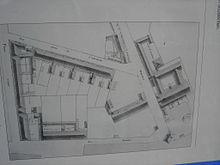New University Street (Mainz)
The New University Street is located in the old city of Mainz between Schiller Street and Cathedral Street. It was created at the end of the 18th century and named in honor of the then owner, the university fund. Houses 5 to 9 are protected as a monument zone.
Location and characteristics

The area in which the street extends was largely undeveloped in the Middle Ages until the Thiermarkt or Dietsmarcktstraße (today Schillerstraße) was expanded. It was only when the Bleichenviertel was drained during the fortification expansion in 1656 under the reign of Elector Johann Philipp von Schönborn and released for development and a connection between Großer Bleiche and Thiermarkt was established that development and development of the site became interesting. The Abbey Altmünster left off in 1699 build on the previously acquired specifically former garden land to 1719 Reihenmietshäuser; these were then known as Altmünster nun houses.
The buildings that lieutenant engineer Rudolf Eickemeyer planned for the university fund of Elector Friedrich Karl Joseph von Erthal dominate today's Neue Universitätsstrasse . On November 15, 1781, the three richest Mainz monasteries - Altmünster , Kartause and Reichklara - and their entire assets were transferred to the newly founded university fund that still exists today. A sketch from the time when Mayence belonged to France under international law (1797-1814) shows how the street branched off at an acute angle from Place Verte and ran to Münsterstrasse, where it came across the Benedictine hospital. Each of the row houses had courtyard wings for the children and servants and a free-standing garden house on the northwest side. Classicism replaced baroque as an architectural style . The buildings in Neue Universitätsstrasse are considered early representatives of this architectural style in Mainz. Even then, the street had its current name, but in French, Rue Neuve de l'université . Today three of the eight terraced houses built at the time still exist.
The street opposite was not built on until the years 1863 to 1867 with the 100-meter long provisions office of the Mainz fortress .
Management
"Financially strong" professors from the university preferred to move into these new apartments, as well as into the houses known as Altmünster nun houses on Thiermarktstrasse, although financially strong professors have to be seen in relative terms, as the professors sublet, as is common in other cities. The professors who rented a room there included the anatomist and anthropologist Samuel Soemmerring , the journalist and statesman Johannes von Müller , the professor of fine sciences Friedrich Lehne , and the later co-founder of the Mainz Jacobin Club , the natural scientist, ethnologist and senior librarian at the University of Georg Forster .
After the visit of the First Consul in October 1804, the whole area between the Altmünster Abbey and the Schönborn Court was requisitioned for billeting of French troops. The professors 'houses were converted into officers' apartments for the first time.
Ludwig I of Hessen-Darmstadt donated house No. 13 to the young Altmünster community as a parsonage in October 1817, with the stipulation that the religious education of young Protestants in Catholic Mainz should be provided. Hermann-Josef Braun: The Christian Mainz in the 19th century . and 20th century. In: Franz Dumont, Ferdinand Scherf, Friedrich Schütz (Hrsg.): Mainz - The history of the city. 2nd Edition. Verlag Philipp von Zabern, Mainz 1999, ISBN 3-8053-2000-0 . P. 965.
The Mainz branch of the "Reich Property Management for the Occupied Rhenish Territory" took over the administration of the confiscated apartments when, after the First World War, Mainz had to provide the French city command with adequate residential buildings for families of officers. Some of the buildings, the three houses 11 to 15, had to give way to the construction of a new tax office building at the beginning of the 1930s. The Altmünster nun houses were abandoned between 1928 and 1930 as a result of a 1926 competition for the Telehaus . Houses 1 and 3 also disappeared by 1953. The remaining houses 5, 7 and 9 were privatized and finally renovated in the 1970s.
literature
- Information board "Historisches Mainz" on the building
- Dr.-Ing. Freund: Telegraph Office and Tax Office in Mainz. In: Zentralblatt der Bauverwaltung united with the construction journal . with news of the Reich and state authorities, published in the preuss. Ministry of Finance, Editor: Dr.-Ing. Gustav Kampmann, 52nd year, Berlin, No. 15, April 6, 1932, pp. 169–173.
Web links
Individual evidence
- ↑ General Directorate for Cultural Heritage Rhineland-Palatinate (ed.): Informational directory of cultural monuments in the district-free city of Mainz (PDF; 1.3 MB). Koblenz 2010
- ↑ List of cultural monuments in Mainz's old town
- ↑ 225 years of the Mainz University Fund Foundation; Festschrift for the 225th anniversary of the Mainz University Fund Foundation 1781-2006
- ^ Samuel Soemmerring was professor of anatomy in Mainz from 1784 to 1797, he lived at Neue Universitätsstrasse 7
- ↑ Marlene Hübel: "Above all the cathedral." Literary city views of Mainz In: Franz Dumont, Ferdinand Scherf, Friedrich Schütz (eds.): Mainz - The history of the city. 2nd Edition. Verlag Philipp von Zabern, Mainz 1999, ISBN 3-8053-2000-0 . Pp. 1173-1203.
- ^ Franz Dumont : Mayence. The French Mainz (1792 / 98-1814). In: Franz Dumont (Ed.), Ferdinand Scherf , Friedrich Schütz : Mainz - The history of the city, 2nd edition. Philipp von Zabern, Mainz 1999, ISBN 3-8053-2000-0 , p. 369
- ^ Hans-Rudolf Neumann: Military building administrations in Mainz on: festung-mainz.de
- ^ Chronicle: Tax Office Mainz-Mitte
Coordinates: 49 ° 59 ′ 57.5 " N , 8 ° 15 ′ 53" E

